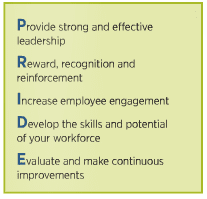Having a skilled and talented workforce is central to a healthy and profitable dealership.
BY GREG SMITH
Just imagine walking through the doors of your dealership noticing the happy and smiling faces of your staff. Your customers are providing rave reviews about your dealership and the service department increased business by 30 percent. Cars are flying off the parking lot and you break another sales record this month. Things are getting better and better. However, for many dealerships this is more of a dream than reality.
The high-performance organization thrives on one key ingredient – a skilled and talented workforce. This is one of the biggest issues facing owners today. Increasing employee turnover, decreasing job satisfaction, changing work ethics and declining job skills provide unique challenges to dealers the world over.
Surveys show upwards to 70 percent of the workforce is not engaged at work. This is the highest level ever recorded in more than 24 years of research. A growing percentage of unhappy employees erodes customer loyalty, decreases sales and increases the cost of turnover. As the economy rebounds, you do not need staff members merely showing up for a paycheck doing the minimum.
The Pride System
The best places to work have one thing in common. They focus their resources to create a high-performance culture. According to the Disney Institute, “culture” is “a system of values and beliefs an organization holds that drives actions and behaviors and influences relationships.”
Creating a high-performance organization involves a five-step process called the PRIDE system.


Provide Strong and Effective Leadership
Effective leadership is the most important element of the PRIDE system.
Dr. Edwards Deming said, “The aim of leadership should be to improve the performance of man and machine, to improve quality, to increase output and simultaneously to bring pride of workmanship to people.”
Employees do not quit their company they quit their boss. Our research shows 46 percent of employees that quit their jobs left because of their first-line supervisor. That is a painful statistic when you consider how expensive it is constantly recruiting, hiring and training new people.
Here are a few suggestions to consider:
- Hold managers personally accountable and responsible for retaining their employees.
- Start measuring the financial cost of turnover and apply the cost to the bottom line.
- Conduct exit interviews to discover the real reasons people quit.
- Train managers to become good leaders.
Reward, Recognition and Appreciation
Fran Tarkenton said to find what motivates people, “you have to find what turns people on.” Personal recognition is a powerful tool that increases job satisfaction and motivation. A pat on the back or a personal note from a peer or a supervisor does wonders. Small, informal celebrations are many times more effective than a once-a-month or once-a-year event.
Graham Weston, co-founder and CEO of Rackspace Managed Hosting, came up with a modified version of the traditional employee-of-the-month program. He gives the keys to his BMW convertible to his top-performing employees for a week. This creative way to reward people has a bigger impact than a cash bonus. He says, “If you gave somebody a cash bonus, it may not have the same effect. “When someone gets to drive my car for a week, they never forget it.”
A successful reward and recognition program does not have to be complicated to be effective. A dealership in Louisville, Ky., has almost eliminated employee turnover by its programs. The employees participate in a profit-sharing plan that could possibly mean $700,000 upon retirement. They are eligible after one year, and become fully vested after six years. Other incentives and benefits provided include:
- Every year, employees celebrate their work anniversary with a cake and a check for $200 for each year employed.
- Twice a year employees’ children receive a savings bond when they bring in their “all A’s” report card.
- To minimize the “we-they” syndrome, every Friday, employees rotate jobs for one hour. For example, the person in the parts department becomes a service technician. This builds a stronger team, and improves communication within the company.
Increase Employee Engagement
People may show up for work, but are they engaged and motivated? Job satisfaction increases when staff can submit their ideas and suggestions to management. This gives them a sense of ownership and pride in their work. Marsha Myers of Lee Hecht Harrison said, “Managers usually overlook the company’s most valuable asset and source of information – their employees. “Creative organizations can find new ways to drive revenue and reduce costs by seeking employee suggestions.”
Riverside Auto Group operates seven dealerships employing 190 people throughout Michigan’s Upper Peninsula and Wisconsin. We found what upset employees the most about their jobs was they “weren’t in charge” of anything. For example, if a guest came in for an oil change and happened to complain her windshield wipers did not work, the associate was powerless to fix the wipers. The associate had to go to a supervisor to get permission to change the wipers or had to tell the guest to make a separate appointment.
The solution was to empower each associate to do whatever he or she could to help the guest – up to a $250 dollar limit. Now, each associate can take ownership of whatever the customer’s concerns are up to that amount without permission from a manager. Giving the employee the ability to improve customer satisfaction motivated the employees. This became a powerful motivator.
Develop the Skills and Potential of Your Workforce
The National Center on the Educational Quality of the Workforce (EQW) found on an average, a 10-percent increase in the workforce education level led to an 8.6-percent gain in total productivity. Ongoing training and development is an important element of a successful organization. It helps people become more productive and effective at what they do. Trained employees will take more responsibility over their jobs. It also gives them internal mobility and a pathway of forward progression in the organization. All employees should have a written training and development plan.
Evaluate and Make Continuous Improvements
Continuous evaluation and never-ending improvement are key components in keeping a competitive edge. Walt Disney said, “If you are coasting, you are going downhill.” The dynamic work environment and changing consumer buying patterns requires increased vigilance.
Organizations should be alert to anything causing job dissatisfaction and decreased performance. Instead of just focusing on the usual metrics, such as profit and loss and sales, dealerships should also focus on a few of the following:
- Conduct exit interviews on the real reasons people leave your organization.
- Ask employees who have been with your business longer than five years why they stay with you.
- Ask new employees what attracted them to your business.
- Evaluate which departments have better or worse retention rates than others.
- Create a retention plan for those key individuals having the greatest impact on profitability and productivity.








